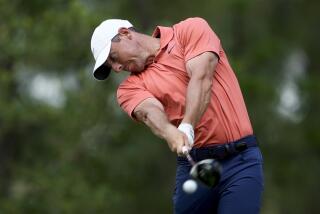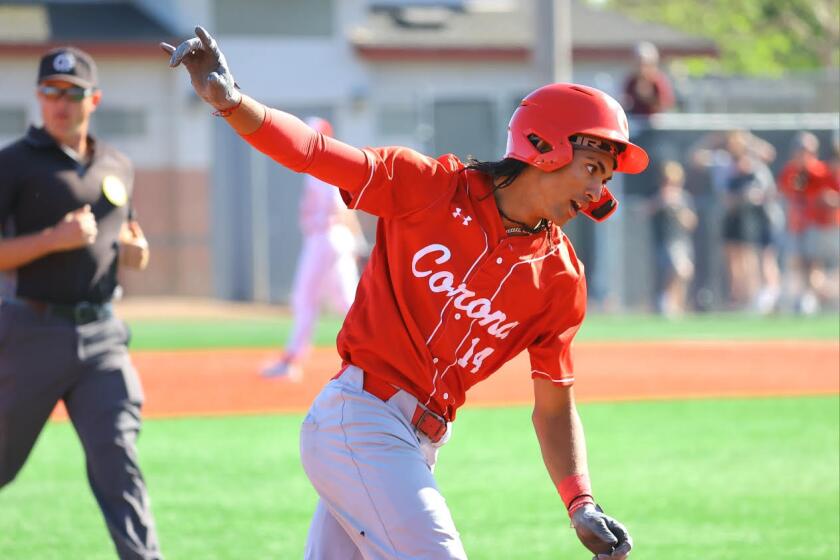The Memories Won’t Be Good
- Share via
CHASKA, Minn. — A U.S. Open is remembered for many things--Tom Watson chipping in out of knee-high rough at Pebble in 1982, Hogan grimly stalking his field to an Open scoring record at Riviera in ‘48, Palmer scattering his field with a wild 65 at Cherry Hills in ‘60, Venturi staggering his way through the heat at Congressional in ’64 to drop his club at 18 and whisper “My God! I’ve won the Open!” while doctors rushed to his side.
A “disaster” is a double bogey at 18, a ball in the water at 12, a four-putt at 16. A “tragedy” is Sam Snead’s blowup at Spring Mill in ‘39, Palmer throwing away seven shots in the last nine holes at Olympic in ‘66, Hogan snap-hooking his fifth Open championship in the rough at Olympic in ’55. Well, this Open will be remembered not for hyperbolic, locker-room-definition tragedy but for a real tragedy--an electrocution on No. 11, a collapsing grandstand behind the ninth green, five people felled by lightning and possible future infirmities the doctors can only guess at.
This has been a star-crossed tournament from the beginning. They should call this the Devil’s Open.
Even the athletic aspects went awry at first. The weather de-fanged the course. Only rain can turn an Open course from a prowling tiger into a mangy pussycat.
They set up Open courses to frustrate the best players in the world, and they do this by making the course preternaturally fast with greens as hard and slippery as plate glass and the fairways as unforgiving as a hanging judge.
It appeared for a while as if this ploy would backfire as greens becamed spongy and fairways forgiving.
The athletic considerations pale beside what did happen--and what might have happened. Cardiac arrest might have been suffered by at least one other of the electric storm victims and the promoters might have to deal with the wisdom of crowding 40,000 people on a plot of ground from which escape was difficult.
The course that was to have been famous for its “signature hole,” the 16th, is now more famous for its signature tree, the willow where lightning struck on Thursday. It will probably stand as the symbol for the 91st U.S. Open longer than any winner. Crowds that used to line fairways asking, “Which one’s Watson?” now crowd around to wonder, “Which one’s the tree?”
But the games went on. They usually do.
And the course made a comeback as it weighed in with a vicious attack on the field Saturday. It was armed and dangerous as morning rains blew out and 25-m.p.h. winds raked the fairways and rippled the greens dry and waxy.
They ran the ribbon clerks out Friday but the big players, the high rollers, were routed by Hazeltine Saturday. Only two of the 65 players on its fairways broke par, Hale Irwin and Nick Price. The reigning U.S. Amateur champion (Phil Mickelson) shot 80. A former U.S. Open and PGA champion (David Graham) shot 80. The reigning Masters champion (Ian Woosnam) shot 79. Two players shot 81. The signature hole yielded no birdies at all and had 28 bogeys and six double bogeys and three triple and three quadruple bogeys. It was a hell hole all day.
Only two players in contention managed to defend themselves from the course all day--Payne Stewart and Scott Simpson--and they shot 73 and 72, respectively. For the first time in five years, there were no scores in the 60s. There were 317 bogeys or worse. The rout of the flower of golf was complete. They should have handed over their nine-irons.
The plight of Corey Pavin pretty much illustrates what happened to the touring pros this day.
What you have to like about Pavin is, you would never take him for a golf pro in the first place. But he is--and one of the best.
First of all, he doesn’t have blond hair or blue eyes, his slacks don’t fit him all that well and he didn’t go to Brigham Young or Wake Forest. He went to UCLA. He grew up around Oxnard, which is not exactly the golf capital of the world.
Corey, who has won nine tournaments, doesn’t do much else like a golf pro. You know how golf pros are. They walk slow. They talk slow. They even eat slow.
They get up on the morning of a tournament and they sleepwalk through their preparations. Watch them as they fit their golf gloves on--like surgeons scrubbing up for surgery.
They’re deliberate, impassive, stoic. They walk after a shot like a guy going to the electric chair. They hover over putts, they waggle. They look as if they’re hoping for a long-distance call.
Not Corey. Corey’s in a rush. He hurries after a shot as if he were chasing a bus. He doesn’t walk, he bounces. He has this funny little duck walk and he seems to be hurrying along five feet in the air.
When he won at Palm Springs one year, he leaped into the air and into the arms of his caddy. He looks too nervous to be a tour player. He has this little toothy grin on his face--Bugs Bunny at the Open. His hair flops loose in the back. He seems to be double-parked. You half expect him to come up to the twosome in front of him at the Open and ask, “Mind if we play through?” You would think he had to go home and wash the windows. He paces between shots like a caged animal.
So, a lot of us were hoping Corey’s game would hold up against the monster that was Hazeltine Saturday. It isn’t as if he couldn’t play. He has already won two tournaments and $721,394 this year. He has earned more than $3 million in all.
Like most of the players, his game was no match for Hazeltine Saturday. Corey hit the wall of pain early. He hit a bunker with his second shot, bogeyed the first hole, then hit his second shot on No. 2 short of the green and it was clear the course was about 10 yards too long for Corey (and almost everybody else) this day.
Corey was one of three players who started the day six-under, one shot behind the leader. The other two were Nolan Henke and Scott Simpson. Simpson was the only one who managed to defend himself. He shot par. Henke finished the day one-under. Pavin finished the day one-over. He shot 79. Hazeltine handed them their heads. It left only a couple of old campaigners still upright at the bell. It is too bad it will not be recognized as an all-time champion of golf courses but as the site of a tragedy much bigger than a flock of 80s. Hole No. 16 should go to join the pantheon of great golf holes, like the 16th at Cypress Point, the 18th at Pebble Beach or the Road Hole at St. Andrews. Instead, this Open will be remembered for a shattered tree on No. 11 where the tournament really was lost.
More to Read
Go beyond the scoreboard
Get the latest on L.A.'s teams in the daily Sports Report newsletter.
You may occasionally receive promotional content from the Los Angeles Times.










